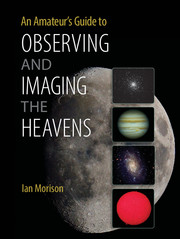Book contents
- Frontmatter
- Dedication
- Contents
- Preface
- Acknowledgements
- Prologue A Tale of Two Scopes
- 1 Telescope and Observing Fundamentals
- 2 Refractors
- 3 Binoculars and Spotting Scopes
- 4 The Newtonian Telescope and Its Derivatives
- 5 The Cassegrain Telescope and Its Derivatives
- 6 Telescope Maintenance, Collimation and Star Testing
- 7 Telescope Accessories
- 8 Telescope Mounts
- 9 The Art of Visual Observing
- 10 Visual Observations of the Moon and Planets
- 11 Imaging the Moon and Planets
- 12 Observing and Imaging the Sun
- 13 Observing and Imaging with an Astro-Video Camera
- 14 DSLR Deep-Sky Imaging
- 15 Imaging with Cooled CCD Cameras
- 16 Auto-Guiding and Drift Scan Alignment
- 17 Spectral Studies
- 18 Improving and Enhancing Images in Photoshop
- Index
- Plate Section
1 - Telescope and Observing Fundamentals
Published online by Cambridge University Press: 05 June 2014
- Frontmatter
- Dedication
- Contents
- Preface
- Acknowledgements
- Prologue A Tale of Two Scopes
- 1 Telescope and Observing Fundamentals
- 2 Refractors
- 3 Binoculars and Spotting Scopes
- 4 The Newtonian Telescope and Its Derivatives
- 5 The Cassegrain Telescope and Its Derivatives
- 6 Telescope Maintenance, Collimation and Star Testing
- 7 Telescope Accessories
- 8 Telescope Mounts
- 9 The Art of Visual Observing
- 10 Visual Observations of the Moon and Planets
- 11 Imaging the Moon and Planets
- 12 Observing and Imaging the Sun
- 13 Observing and Imaging with an Astro-Video Camera
- 14 DSLR Deep-Sky Imaging
- 15 Imaging with Cooled CCD Cameras
- 16 Auto-Guiding and Drift Scan Alignment
- 17 Spectral Studies
- 18 Improving and Enhancing Images in Photoshop
- Index
- Plate Section
Summary
This chapter will discuss the fundamentals of telescopes and observing which are independent of the telescope type or, as in the case of the contrast of a telescope image, dependent on aspects of the telescope design. Later sections in the chapter will discuss the effects of the atmosphere on image quality due to the ‘atmospheric seeing’ and the faintness of stars that can be seen due to its ‘transparency’. The final sections will give details as to how the stars are charted and named on the celestial sphere and how time, relating to both the Earth (Universal Time) and the stars (sidereal time) are determined.
There is one problem that can cause some confusion: the mixing of two units of length: millimetres and inches. Quite a number of US and Russian telescopes have their apertures defined in inches, and the two common focusers have diameters of 1¼ and 2 inches. However, the focal lengths of telescopes and eyepieces are always specified in millimetres, as are the apertures of more recent US, Japanese and European telescopes. In this book I have used the unit which is appropriate and have not tried to convert inches into millimetres when, for example, referring to a 9.25-inch Schmidt-Cassegrain telescope. In calculations and where no specific telescope is referred to, millimetres are always used.
- Type
- Chapter
- Information
- Publisher: Cambridge University PressPrint publication year: 2014



